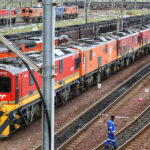Fabulous fire protection for Fuchs
Fabulous fire protection for Fuchs
Fuchs Lubricants South Africa’s new warehouse in Isando, Johannesburg, has been constructed as part of the first phase of its expansion project. The warehouse not only incorporates the latest technology, but also complies with stringent fire detection and prevention requirements.
The expansion was first mooted five years ago, with a project management team assembled in 2018 to thrash out the specifications for a planned new warehouse and blending plant.
The decision by a neighbouring original equipment manufacturer to relocate to a new facility allowed Fuchs to acquire the adjacent site, adding impetus to the project. Board approval was received in April 2020 and construction kicked off in June of that year, with DRA Global as the main engineering, procurement, and construction management contractor.
“We had worked with DRA Global prior to that on our new grease plant and were fortunate to retain the same project manager for our latest expansion,” explains Fuchs Lubricants South Africa MD Paul Deppe. It was eventually decided to split the expansion into two phases due to the substantial investment required.
With phase one now completed, planning is already well advanced for the next phase, with a full study having been undertaken into the new blending plant. “We have done quite a bit of work on the new blending plant already, which is being used for storage at the moment,” says ASP Fire CEO Michael van Niekerk, who was appointed as the fire engineering consultant.
“The biggest challenge was that being a hazardous materials warehouse, it was automatically classified as high risk,” he continues. “The presence of combustible liquids made the fire protection requirements even more onerous, as there were very specific requirements for the building envelope.” The plan is to install additional fire detection and prevention equipment as an added layer of protection. “We are familiar working in high-risk environments and were able to bring our expertise and experience to bear,” adds Van Niekerk. “It was a real team effort that went very smoothly given all the constraints posed by Covid-19 on such large-scale projects.”
The warehouse features 13 m-high cast concrete tilt-up panels that provide a firewall between the warehouse and nearby production facilities. The use of these panels in this size is believed to be a first in South Africa.
“Based on radiation heat calculations, we were able to advise how high the firewalls had to be to comply with the requirements,” highlights Van Niekerk.
The firewalls had to comply with three main criteria: insulation, integrity, and the ability to structurally deal with the potential collapse of the internal racking system during a fire incident. This meant the firewalls could not collapse or deform beyond very specific requirements.
“It was a complex, high-risk building that necessitated us designing a system to cater for a range of local and international requirements,” Van Niekerk expands. “What is interesting about international regulations is that they reference ‘ignitable’ substances, as opposed to only combustible or flammable. This meant stringent flashpoint requirements not only for specific types of liquids, but more importantly for the type of container. The moment you store an ignitable liquid such as oil in a plastic container, it becomes a high-risk item, because obviously plastic can melt or glass break. Steel is different because it maintains the structural integrity of the container.”
A particular achievement of the plan and rational design compiled by ASP Fire was that it managed to retain the existing on-site pumps and tanks, without any need to upscale these components, resulting in a significant cost-saving and speeding up the project timeline.
“It has been an enormous success. I would like to extend our sincere gratitude to all the contractors and consultants, as well as our own staff who were involved,” enthuses Deppe. “It was a fantastic partnership at the end of the day, that allowed us to realise a project of this scale and complexity.”
Published by
Focus on Transport
focusmagsa




